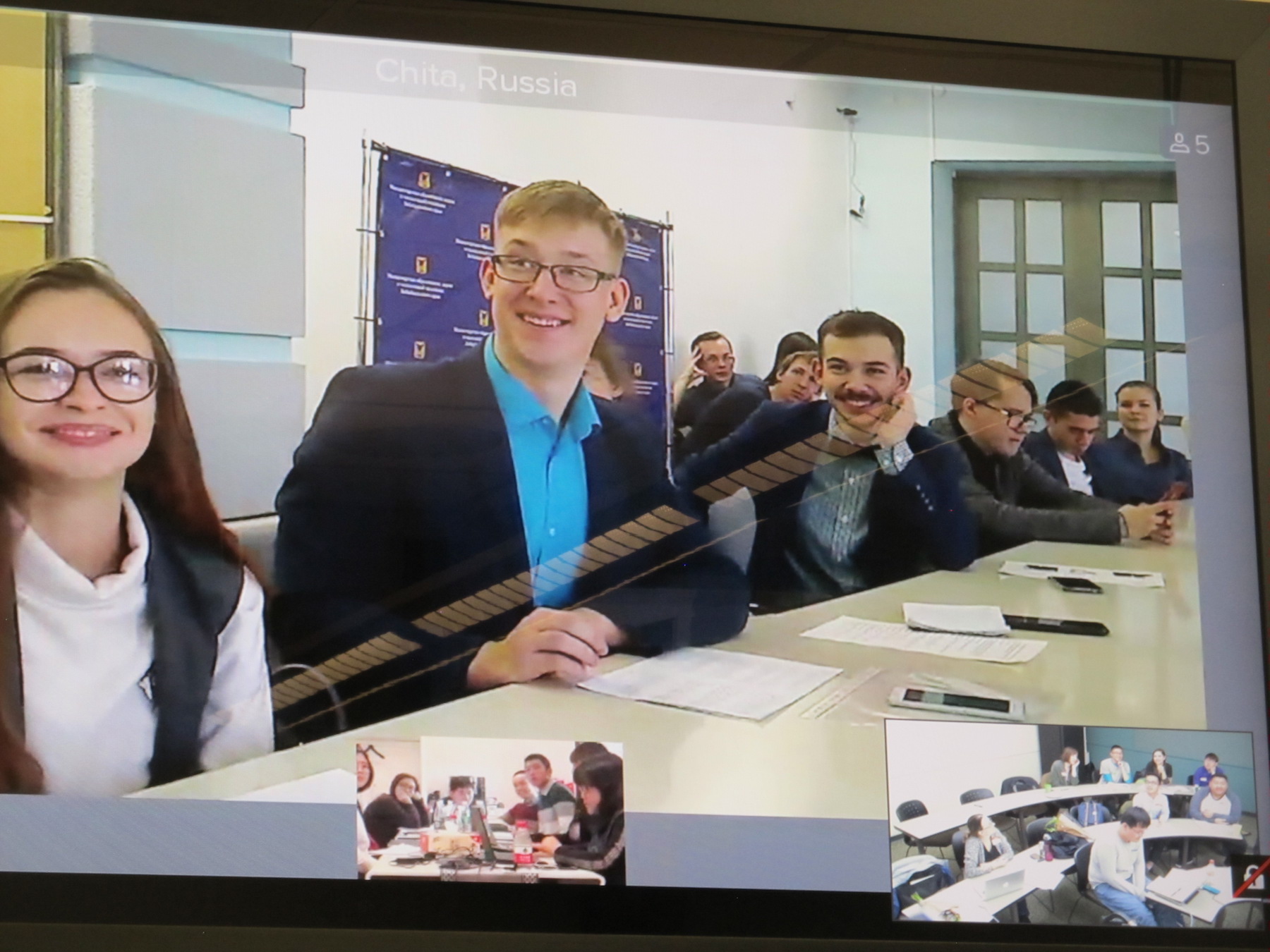Tom in Chita 2019, No. 6: THE TROUT FARM

On Sunday June 9th I had the chance to visit Chita’s only trout farm. It is the livelihood, and great risk, of Tolya and Valya Turkov, the parents of Olya Kulakovskaya. My connection to Olya will seem complicated, but it really isn’t: Victor Kulakovsky and his wife Elena Anisimova are close friends of Olga Fleshler and got her involved, and through her got Siberian Bridges involved, with the Children’s Center in Petrovsk-Zabaikalsky. Victor’s son is Vova, and Vova’s wife is Olya. All of us (the above-named plus me) were together in Petrovsk in the summer of 2015, and Vova and Olya have a strong interest in the Center as well. In addition, last summer I was asked if I would be their new son Vsevolod’s godfather (they chose to know the sex of their child early in the pregnancy). Ceva, as he is called, was born January 8th this year and the christening will be July 6th.
Last summer, the Taste of Zabaikalye tour group was all invited most graciously to Elena Anisimova’s birthday party at their dacha. I had hoped to include a “dacha day” in the tour, but this was even more special. The birthday feast under the new-last-year gazebo included Olya’s parents, and that was the first time I met them. They were much fun. Valya, when trying to explain what she and Tolya did for a living for us non-Russian speakers exuberantly began to baa like a goat and cluck like chicken, and we understood immediately. They have goats and chickens and turkeys and ducks and geese on their farm, but the main project is the trout farm.
So Sunday noon, Vova picked me up in his work car. He works for GAI, the roads part of the police, which is all national level. The car is a Russian Lada. Though not very old, it rode like a car from the 90s—solid and not sleek. Our first stop was a fruit and vegetable store run as they often are here by a family from one of the “stans”–Uzbekistan, Tajikistan or another. The produce was terrific looking and a visit was worth it just for the smells. Clearly this was a valued shop as it was full that Sunday morning, and the line at the cashier was 10 people long. I held a place in line while Vova collected things and piled them in my arms: cucumbers, a kind of wild garlic grass that makes a special salad with green onions and smetana (sour cream but better), tomatoes, apples, dill, green onions, grapes.
Then we drove to a huge warehouse type store called Absolute. It felt like we entered Costco. It may have sold more than just food items, but we got in and out quickly so I didn’t explore. It was clearly modeled on the huge US stores, or maybe European variants of the same. Oversized, bright, clean, with a long bank of cashiers and huge shopping carts and things to buy towering over us on tall shelves. There were a couple huge aisles of liquor and beer, plus a little kiosk decanting kegged beer into 2 and 3 liter bottles. Rows and rows of cakes and breads, too. Those were as far as we went in the store. We were there for beer and kvas, an old-style soft drink made most typically from dark toasted bread, sugar and yeast that tastes much better than it sounds!), and I wanted to bring some dessert (as I was learning—painfully slowly—that the polite thing to do was to always show up with something if at all possible), so Vova picked out some cupcakes and a small torte of a butter cream alternating with a dense but not overly sweet cake. I managed to pay for it all, but before I could, Vova pulled out his discount card for the Absolute chain and we got 20% off.
And then we were on the road to the farm. It was on the road to Lake Arakhlei about 30 minutes away, just beyond the Buryat village of Ugdan. Arakhlei would be another 45 minutes farther. I’ve only seen pictures of it, but the Ugdan datsan, Buddhist temple, is big and spectacular.
The farm is just off a 10th of a mile from the road and doesn’t look like much, just a few low buildings. But when we got close you could see that the main building, though low, was very big—a large concrete warehouse-like building that housed the current trout farm in a few rooms, and the large open area that would be the full operation, as well as one corner of it being Tolya and Valya’s simple farmhouse of two rooms, a bedroom and a kitchen/living room. The toilet was a pair of new outhouses 100 yds away, one for Tolya and Valya, and the other for the employees. I’m sure there was a banya for bathing, but I didn’t see it.



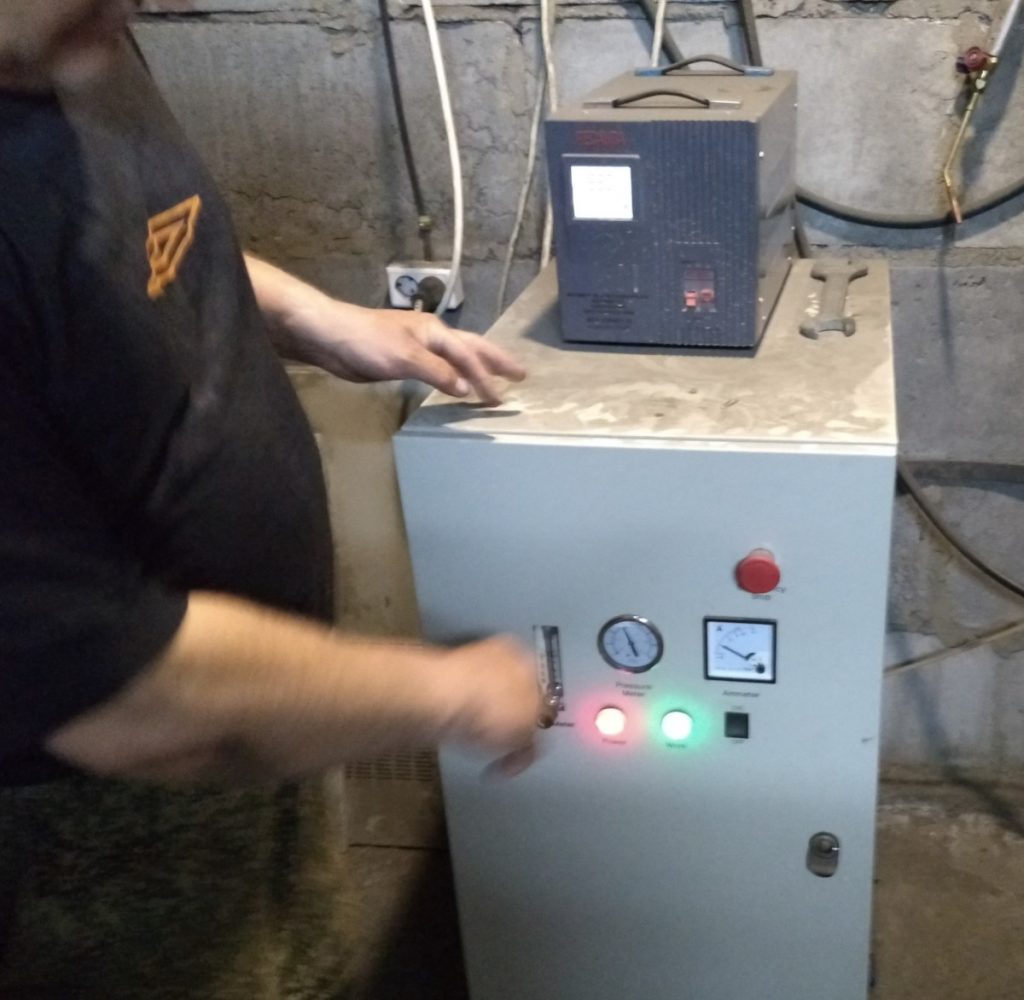
Soon after arrival Tolya rounded Vova and me up for a tour. He showed me first where the 100+ meter deep well was inside the large warehouse, and explained the warehouse was for the full operation of many tanks for the fish and in one corner would be the water purification tanks where the water will be aerated. He showed me the oxygen supplier connected to the water oxygenator, and also the water heater to bring the temperature up to what the trout prefer, something like 5-10 degrees Celsius higher than the well water. The water was very pure, but it is also quite minerally, as is all the groundwater of this region—famously so, in fact, and bottled and sold nationally because of that—so there is a device that removes minerals.


He showed me the roe hatchery flats with slats through which the tiny hatched fish wriggle and are taken to the next step (the tanks?). And then he showed me the tanks. There were four of them, made of heavy coated canvas, standing 5 ft high and maybe 8 feet in diameter. There were circulating pumps keeping the water in motion and the fish were swimming in a ring in a dense school, seemingly not moving because the water around them was moving. Each tank held 5000 fish on average making 20,000 fish in his operation at the moment. They were rainbow trout. Two tanks, his first operation, hold fish from American roe bought from the State of Washington last year or the year before. Two tanks held the next addition to his operation: fish from Russian roe bought from the Sochi area. He said the American roe produced only sterile females, but the Russian females are fertile, so he is able to harvest eggs and grow more fish from his own stock
I asked how big they would grow and he said he could grow them as much as 20 inches long, but most people here prefer 8-10 inch fish. He said the large fish become too fatty. Vova then piped in that he liked the larger fattier fish himself.
Then Tolya took us to see the rest of the farm. There is a pond next to it that will have a fish growing zone inside netting. Two workers were in the process of constructing a large frame on the bank that would float on the pond with the farmed fish underneath. There was a small cage with turkey chicks in the yard. We saw the large kitchen garden with the two modern greenhouses, one for tomatoes the other for cucumbers. Everything looked planted and a few rows were beginning to green. We walked down past the outhouses to a couple enclosures for the goats and the fowl: ducks, chickens, turkeys, geese. They were raising chickens for eggs, but also another variety Tolya said was just for meat, ones that could grow as large and 9-10 kgs like turkeys (19-22 lbs.). We saw a turkey sitting on a nest full of eggs.

Tolya left us and Vova and I walked on down a very rough track. It was rough because it was created by two huge diesel shovels that were digging a series of ponds, 27 in all when and if the whole farm project reaches fruition. They will be for raising a variety of fish. The one that was mentioned “karass” a type of small catfish. They also hope to have one of the ponds be very large and a place where people can build weekend cabins or rent them and go fishing. Two of these ponds were mostly dug, big rough holes in the ground a few meters deep. Vova said that the plan was to have them all dug in two years, but money was the eternal problem, and things would happen according to available funds.


The land was a 49 year lease from the government of 117 hectares or just under 300 acres. The Chita River flows along its northeastern edge. It is flat, much of it is open, and a large part has bushes and deciduous trees. At one point, one of Tolya’s employees returned from a trip into the woods with a huge armful of birch branches with which he would make the veniky or birch faggots used in a Russian banya. Early June is the best time to collect the branches when the leaves are young and soft.
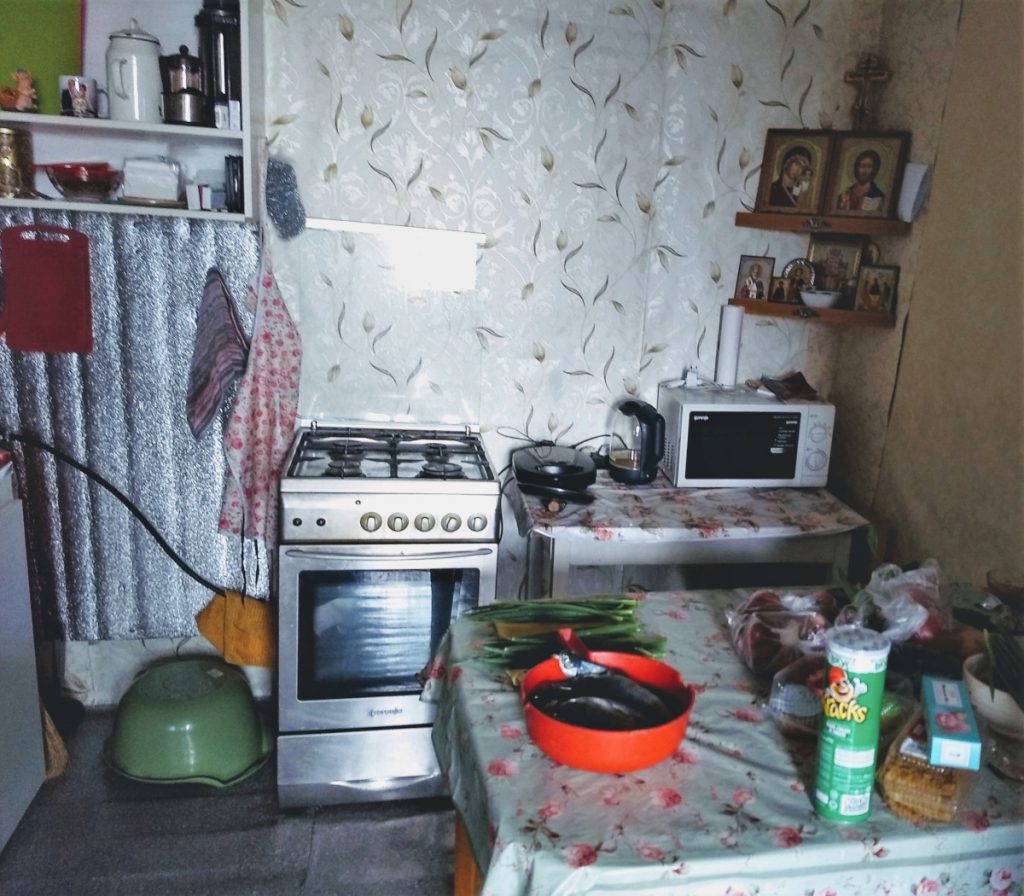
Then it was time for dinner of, what else? Trout! The small grilled trout were tender and flavorful. They needed no sauce, just a little salt and pepper. The meal started with okroshka and there was a small argument between Tolya and Vova about how it is best made. Okroshka is a summer cold soup. The basis is really a salad of diced ham or sausage, cucumber, and radishes, dill, hard-boiled eggs. (NOTE: when I asked Raisa Nikolaevna, a Gorod Detstva English teacher with whom I’m working at the moment, for help with the recipe, she said it was one of those dishes that was very individual with each maker devising their own mixture. She also said is was poor people’s food, being made with very simple ingredients, and often contained foraged elements like wild herbs and greens like dandelions that are considered weeds. She said her husband didn’t like it for that reason.) Over this is poured the liquid. Vova was saying it would be kvas, and that was how I had first tried it the year before. But Tolya insisted I have it with soured whey (sivorotka ?????????), a bit of sugar, salt and a dollop of smetana. Both versions are good and are really different than each other. I did prefer the whey version. It was the first time I’d ever had, or even seen, whey. The sivorotka that Valya had came in a plastic bag (a minimalist packaging also used for milk here along with the more familiar cartons and bottles). I’ve been asked a few times on this trip how I would compare American and Russian food. I’ve always felt that Russian food flavors are often quite familiar, though there is more use of garlic and dill. However, some things have nothing comparable in American foods, and okroshka is one of them. Easy to make, very straightforward, VERY healthy, and really different!
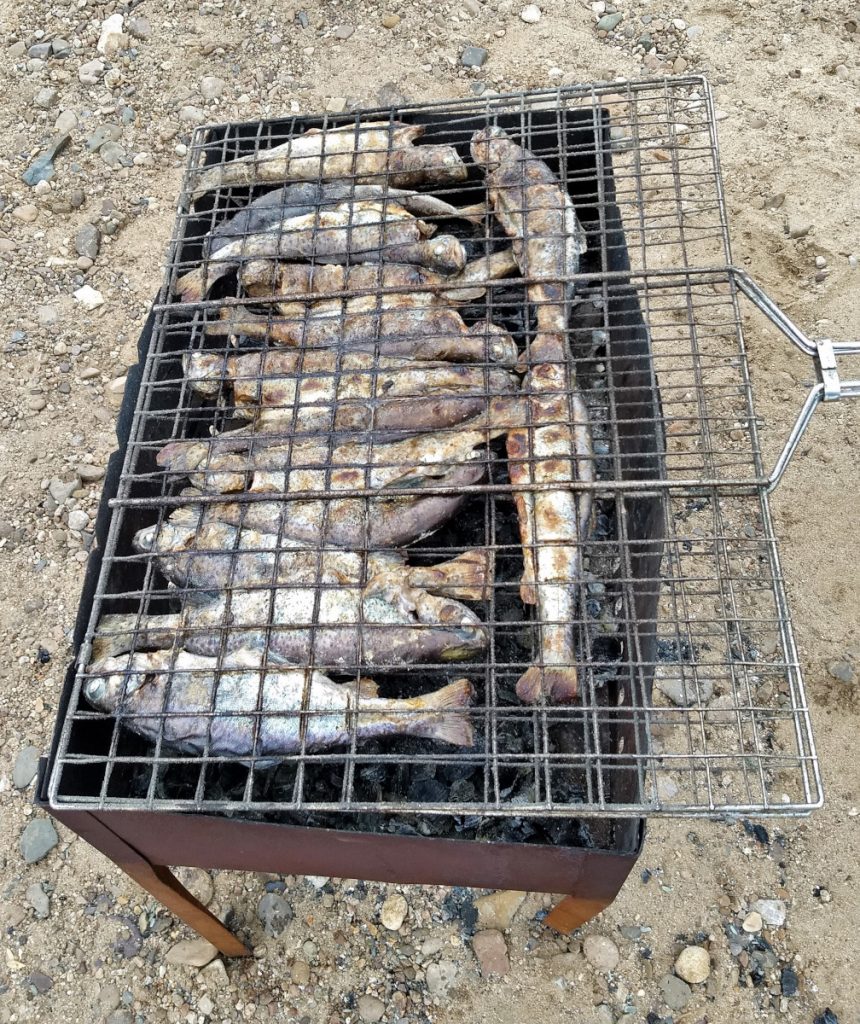
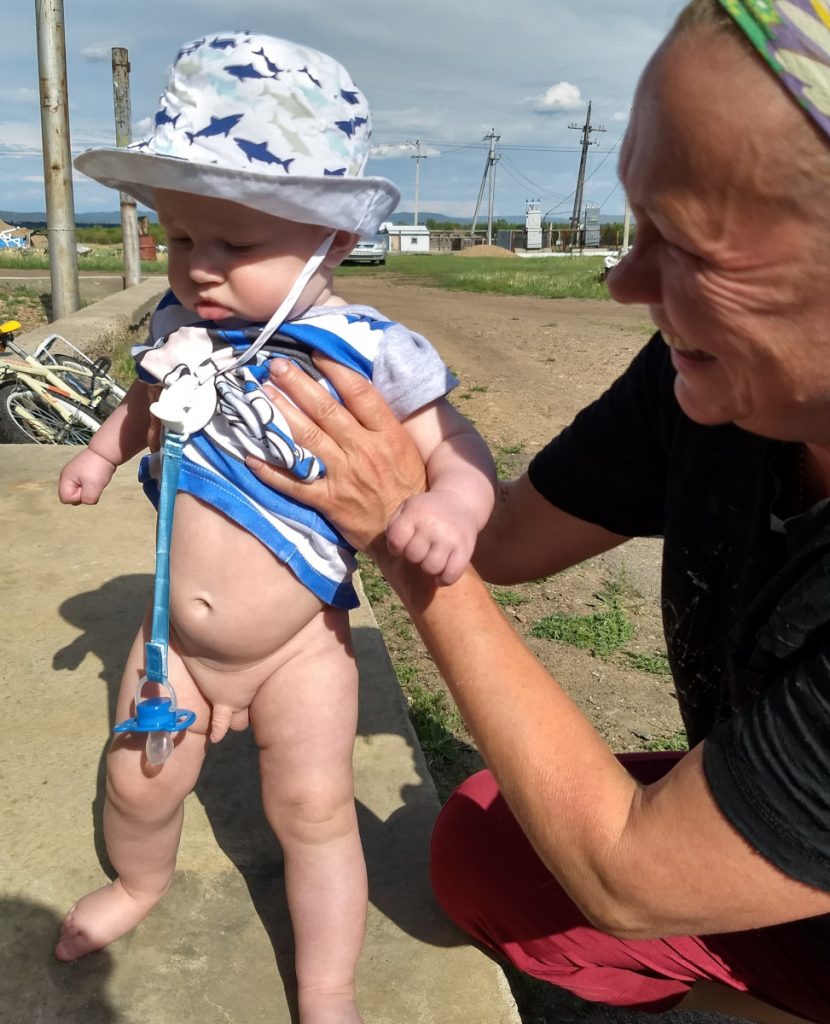


Tolya, Valya, her sister and I all toasted with vodka at this meal. Tolya and I took on the traditional men’s role (much less common among the younger generations now) of getting good and drunk. To be honest, this happens less and less on my visits. As an infrequently drinker, I can’t deny I enjoy these moments with friends, at least the first few hours of them anyway. I was told that Tolya once drank a great deal and was quite overweight, but since taking on this great farming project he is quite trim and rarely drinks at all. Because Olya and Vova were both driving neither drank. Vova was drinking alcohol-free Budweiser which he said was the best tasting of the lot.
They are selling trout now to restaurants and to anyone who will make the drive out. 600 rubles per kilo or about $4.25 a pound at current exchange rates—a real bargain compared to US prices, though transportation costs from the US to get it are a little steep…

